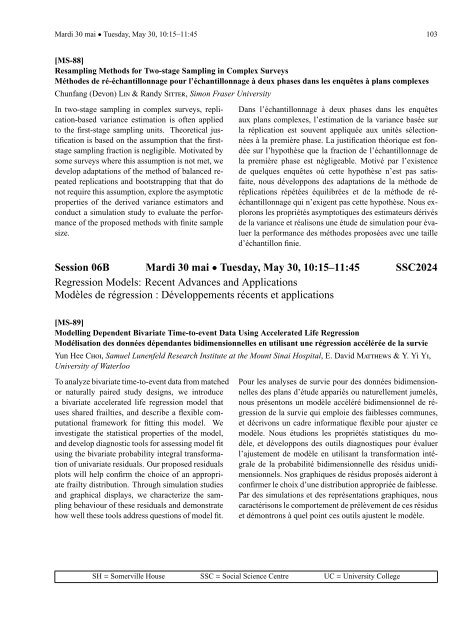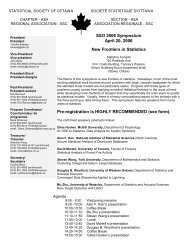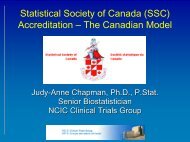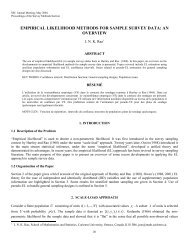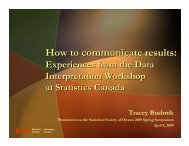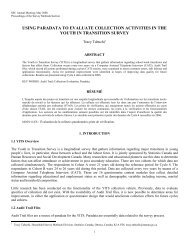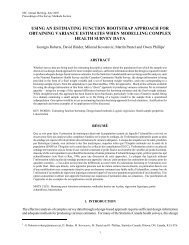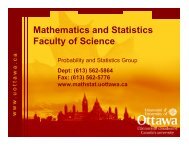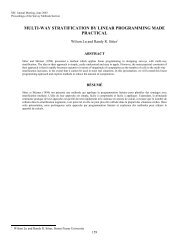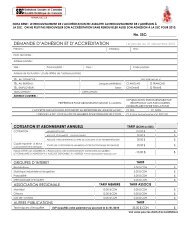102 Mardi 30 mai • Tuesday, May 30, 10:15–11:45Session 06A Mardi 30 mai • Tuesday, May 30, 10:15–11:45 SSC3018Some Current Developments in the Analysis of Complex Survey DataDéveloppements récents en analyse de données d’enquêtes complexes[MS-86]Analysis of Longitudinal Survey Data with Missing Observations: An Application to the NationalLongitudinal Survey of Children and Youth (NLSCY)Analyse de données longitudinales en présence d’observations manquantes : une application à l’Enquêtelongitudinale nationale sur les enfants <strong>et</strong> les jeunes (ELNEJ)Ivan CARRILLO-GARCIA, University of Waterloo, Milorad KOVACEVIC, Statistics <strong>Canada</strong>, Changbao WU, University ofWaterlooAll surveys, either cross-sectional or longitudinal,contain nonresponse. Under these circumstancesToutes les enquêtes, qu’elles soient transversales ou longitudinales,sont suj<strong>et</strong>tes à la non-réponse. Dans ces conditions,one must make assumptions about the response il est nécessaire d’établir des postulats quant au mécanismemechanism. There is extensive literature about de réponse. La littérature au suj<strong>et</strong> de la non-réponse dansnonresponse for cross-sectional surveys. For lon- les enquêtes transversales est abondante. Cependant, le progitudinalsurveys, the missing data problem, the blème des données manquantes, les propriétés des différentsproperties of different response mechanisms, and mécanismes de réponse <strong>et</strong> leurs impacts sont moins bientheir impacts on variances are much less known. connus dans le cas d’études longitudinales. Sous l’hypothèseAssuming MAR, we apply the Weighted GEE de données manquantes aléatoirement, nous appliquons lamodeling, following the lines of earlier research modélisation par EEG pondérées, suivant l’approche de reforlongitudinal studies under non-survey s<strong>et</strong>tings cherche antérieure en études longitudinales (Robins <strong>et</strong> al.,(Robins <strong>et</strong>.al., 1995), to estimate the regression 1995), afin d’estimer les coefficients de régression <strong>et</strong> leur vacoefficientsand their joint randomization variance riance conjointe lorsque des abandons ou de la non-réponsewhen either dropouts or intermittent nonresponse intermittente sont présents. Nous utilisons l’ELNEJ pour nosis present. We use the NLSCY for our analyses. analyses.[MS-87]Treatments for the Problem of Identification of Links in Indirect SamplingTraitements pour le problème de l’identification des liens en échantillonnage indirectXiaojian XU, University of Alberta, Pierre LAVALLÉE, Statistics <strong>Canada</strong>In the context of indirect sampling, we address theproblem of overestimation caused by link nonresponsewhen using generalized weight sharem<strong>et</strong>hod (GWSM). A few adjustment m<strong>et</strong>hods, withand without use of auxiliary variables, have beenconstructed. The properties of these m<strong>et</strong>hods werestudied in a simulation study based on the longitudinalsurvey data. The simulation results show thatthese adjusted using the GWSM perform well in re<strong>du</strong>cingboth, the estimation bias and the variance.The advancement in bias re<strong>du</strong>ction is significant.Dans le contexte de l’échantillonnage indirect, nous nousintéressons au problème de la surestimation causée parla non-réponse de lien lorsque la méthode de la part despoids généralisée (MPPG) est utilisée. Quelques méthodesd’ajustement, utilisant ou non des variables auxiliaires, ontété construites. Les propriétés de ces méthodes ont été étu-diées dans une étude de simulation basée sur des donnéeslongitudinales. Les résultats de simulation montrent que lesajustements utilisant la MPPG performent bien en ré<strong>du</strong>isantà la fois le biais <strong>et</strong> la variance. Le progrès en ré<strong>du</strong>ction debiais est significatif.SH = Somerville House SSC = Social Science Centre UC = University College
Mardi 30 mai • Tuesday, May 30, 10:15–11:45 103[MS-88]Resampling M<strong>et</strong>hods for Two-stage Sampling in Complex SurveysMéthodes de ré-échantillonnage pour l’échantillonnage à deux phases dans les enquêtes à plans complexesChunfang (Devon) LIN & Randy SITTER, Simon Fraser UniversityDans l’échantillonnage à deux phases dans les enquêtesaux plans complexes, l’estimation de la variance basée surla réplication est souvent appliquée aux unités sélection-nées à la première phase. La justification théorique est fon-dée sur l’hypothèse que la fraction de l’échantillonnage dela première phase est négligeable. Motivé par l’existencede quelques enquêtes où c<strong>et</strong>te hypothèse n’est pas satis-faite, nous développons des adaptations de la méthode deréplications répétées équilibrées <strong>et</strong> de la méthode de ré-échantillonnage qui n’exigent pas c<strong>et</strong>te hypothèse. Nous ex-plorons les propriétés asymptotiques des estimateurs dérivésde la variance <strong>et</strong> réalisons une étude de simulation pour éva-luer la performance des méthodes proposées avec une tailled’échantillon finie.In two-stage sampling in complex surveys, replication-basedvariance estimation is often appliedto the first-stage sampling units. Theor<strong>et</strong>ical justificationis based on the assumption that the firststagesampling fraction is negligible. Motivated bysome surveys where this assumption is not m<strong>et</strong>, wedevelop adaptations of the m<strong>et</strong>hod of balanced repeatedreplications and bootstrapping that that donot require this assumption, explore the asymptoticproperties of the derived variance estimators andcon<strong>du</strong>ct a simulation study to evaluate the performanceof the proposed m<strong>et</strong>hods with finite samplesize.Session 06B Mardi 30 mai • Tuesday, May 30, 10:15–11:45 SSC2024Regression Models: Recent Advances and ApplicationsModèles de régression : Développements récents <strong>et</strong> applications[MS-89]Modelling Dependent Bivariate Time-to-event Data Using Accelerated Life RegressionModélisation des données dépendantes bidimensionnelles en utilisant une régression accélérée de la survieYun Hee CHOI, Samuel Lunenfeld Research Institute at the Mount Sinai Hospital, E. David MATTHEWS & Y. Yi YI,University of WaterlooTo analyze bivariate time-to-event data from matchedor naturally paired study designs, we intro<strong>du</strong>cePour les analyses de survie pour des données bidimensionnellesdes plans d’étude appariés ou naturellement jumelés,a bivariate accelerated life regression model that nous présentons un modèle accéléré bidimensionnel de réusesshared frailties, and describe a flexible com- gression de la survie qui emploie des faiblesses communes,putational framework for fitting this model. We <strong>et</strong> décrivons un cadre informatique flexible pour ajuster ceinvestigate the statistical properties of the model, modèle. Nous étudions les propriétés <strong>statistique</strong>s <strong>du</strong> moanddevelop diagnostic tools for assessing model fit dèle, <strong>et</strong> développons des outils diagnostiques pour évaluerusing the bivariate probability integral transforma- l’ajustement de modèle en utilisant la transformation intétionof univariate resi<strong>du</strong>als. Our proposed resi<strong>du</strong>als grale de la probabilité bidimensionnelle des rési<strong>du</strong>s unidiplotswill help confirm the choice of an appropri- mensionnels. Nos graphiques de rési<strong>du</strong>s proposés aideront àate frailty distribution. Through simulation studies confirmer le choix d’une distribution appropriée de faiblesse.and graphical displays, we characterize the sam- Par des simulations <strong>et</strong> des représentations graphiques, nouspling behaviour of these resi<strong>du</strong>als and demonstrate caractérisons le comportement de prélèvement de ces rési<strong>du</strong>show well these tools address questions of model fit. <strong>et</strong> démontrons à quel point ces outils ajustent le modèle.SH = Somerville House SSC = Social Science Centre UC = University College
- Page 1 and 2:
3Table of Contents • Table des ma
- Page 3 and 4:
Welcome • Bienvenue 5détails sur
- Page 5 and 6:
7Organizers • OrganisateursLocal
- Page 7 and 8:
General Information • Information
- Page 9 and 10:
General Information • Information
- Page 12 and 13:
14 Committees and Meetings • Comi
- Page 14 and 15:
16 Committees and Meetings • Comi
- Page 16 and 17:
18 List of Sessions • Liste des s
- Page 18 and 19:
20 List of Sessions • Liste des s
- Page 20 and 21:
22 List of Sessions • Liste des s
- Page 22 and 23:
24 Dimanche 28 mai • Sunday, May
- Page 24 and 25:
26 Lundi 29 mai • Monday, May 29,
- Page 26 and 27:
28 Lundi 29 mai • Monday, May 29,
- Page 28 and 29:
30 Lundi 29 mai • Monday, May 29,
- Page 30 and 31:
32 Lundi 29 mai • Monday, May 29,
- Page 32 and 33:
34 Lundi 29 mai • Monday, May 29,
- Page 35 and 36:
Mardi 30 mai • Tuesday, May 30, 1
- Page 37 and 38:
Mardi 30 mai • Tuesday, May 30, 1
- Page 39 and 40:
Mardi 30 mai • Tuesday, May 30, 1
- Page 41 and 42:
Mardi 30 mai • Tuesday, May 30, 1
- Page 43 and 44:
Mardi 30 mai • Tuesday, May 30, 1
- Page 45 and 46:
Mardi 30 mai • Tuesday, May 30, 1
- Page 47 and 48:
Mardi 30 mai • Tuesday, May 30, 1
- Page 49 and 50: Mercredi 31 mai • Wednesday, May
- Page 51 and 52: Mercredi 31 mai • Wednesday, May
- Page 53 and 54: Mercredi 31 mai • Wednesday, May
- Page 55 and 56: Mercredi 31 mai • Wednesday, May
- Page 57 and 58: Mercredi 31 mai • Wednesday, May
- Page 59 and 60: 61Abstracts • RésumésSession 0
- Page 61 and 62: Dimanche 28 mai • Sunday, May 28,
- Page 63 and 64: Lundi 29 mai • Monday, May 29, 08
- Page 65 and 66: Lundi 29 mai • Monday, May 29, 10
- Page 67 and 68: Lundi 29 mai • Monday, May 29, 10
- Page 69 and 70: Lundi 29 mai • Monday, May 29, 10
- Page 71 and 72: Lundi 29 mai • Monday, May 29, 10
- Page 73 and 74: Lundi 29 mai • Monday, May 29, 10
- Page 75 and 76: Lundi 29 mai • Monday, May 29, 10
- Page 77 and 78: Lundi 29 mai • Monday, May 29, 10
- Page 79 and 80: Lundi 29 mai • Monday, May 29, 10
- Page 81 and 82: Lundi 29 mai • Monday, May 29, 13
- Page 83 and 84: Lundi 29 mai • Monday, May 29, 13
- Page 85 and 86: Lundi 29 mai • Monday, May 29, 15
- Page 87 and 88: Lundi 29 mai • Monday, May 29, 15
- Page 89 and 90: Lundi 29 mai • Monday, May 29, 15
- Page 91 and 92: Lundi 29 mai • Monday, May 29, 15
- Page 93 and 94: Lundi 29 mai • Monday, May 29, 15
- Page 95 and 96: Lundi 29 mai • Monday, May 29, 15
- Page 97 and 98: Lundi 29 mai • Monday, May 29, 15
- Page 99: Mardi 30 mai • Tuesday, May 30, 0
- Page 103 and 104: Mardi 30 mai • Tuesday, May 30, 1
- Page 105 and 106: Mardi 30 mai • Tuesday, May 30, 1
- Page 107 and 108: Mardi 30 mai • Tuesday, May 30, 1
- Page 109 and 110: Mardi 30 mai • Tuesday, May 30, 1
- Page 111 and 112: Mardi 30 mai • Tuesday, May 30, 1
- Page 113 and 114: Mardi 30 mai • Tuesday, May 30, 1
- Page 115 and 116: Mardi 30 mai • Tuesday, May 30, 1
- Page 117 and 118: Mardi 30 mai • Tuesday, May 30, 1
- Page 119 and 120: Mardi 30 mai • Tuesday, May 30, 1
- Page 121 and 122: Mardi 30 mai • Tuesday, May 30, 1
- Page 123 and 124: Mardi 30 mai • Tuesday, May 30, 1
- Page 125 and 126: Mardi 30 mai • Tuesday, May 30, 1
- Page 127 and 128: Mardi 30 mai • Tuesday, May 30, 1
- Page 129 and 130: Mardi 30 mai • Tuesday, May 30, 1
- Page 131 and 132: Mardi 30 mai • Tuesday, May 30, 1
- Page 133 and 134: Mardi 30 mai • Tuesday, May 30, 1
- Page 135 and 136: Mardi 30 mai • Tuesday, May 30, 1
- Page 137 and 138: Mardi 30 mai • Tuesday, May 30, 1
- Page 139 and 140: Mardi 30 mai • Tuesday, May 30, 1
- Page 141 and 142: Mardi 30 mai • Tuesday, May 30, 1
- Page 143 and 144: Mercredi 31 mai • Wednesday, May
- Page 145 and 146: Mercredi 31 mai • Wednesday, May
- Page 147 and 148: Mercredi 31 mai • Wednesday, May
- Page 149 and 150: Mercredi 31 mai • Wednesday, May
- Page 151 and 152:
Mercredi 31 mai • Wednesday, May
- Page 153 and 154:
Mercredi 31 mai • Wednesday, May
- Page 155 and 156:
Mercredi 31 mai • Wednesday, May
- Page 157 and 158:
Mercredi 31 mai • Wednesday, May
- Page 159 and 160:
Mercredi 31 mai • Wednesday, May
- Page 161 and 162:
Mercredi 31 mai • Wednesday, May
- Page 163 and 164:
Mercredi 31 mai • Wednesday, May
- Page 165 and 166:
Mercredi 31 mai • Wednesday, May
- Page 167 and 168:
Mercredi 31 mai • Wednesday, May
- Page 169 and 170:
Mercredi 31 mai • Wednesday, May
- Page 171 and 172:
Mercredi 31 mai • Wednesday, May
- Page 173 and 174:
Mercredi 31 mai • Wednesday, May
- Page 175 and 176:
Mercredi 31 mai • Wednesday, May
- Page 177 and 178:
179Author Index • Index des auteu
- Page 179 and 180:
Author Index • Index des auteurs
- Page 181 and 182:
Author Index • Index des auteurs
- Page 183 and 184:
Author Index (per session) • Inde
- Page 185 and 186:
Author Index (per session) • Inde
- Page 187:
Author Index (per session) • Inde


